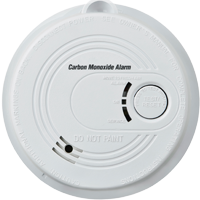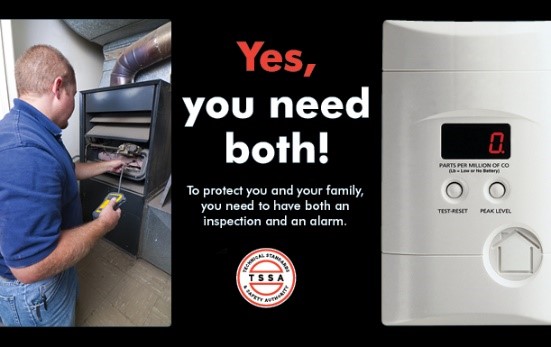The best way to ensure that you and your family are not exposed to carbon monoxide is to eliminate this poisonous gas at the source.
Have a trained, TSSA-certified fuels technician check your furnace, gas, stove, fireplace or fuel-burning appliances on a yearly basis.
Install a tested and certified CO (by CSA, ULC or other recognized certification body) alarm on each level of your home, cottage or boat cabin. These will warn you of rising levels of CO, giving you and your family time to escape.
Without CO alarms, the only way to know if CO is present is when the physical symptoms of CO poisoning become apparent.
Have a trained, TSSA-certified fuels technician check your furnace, gas, stove, fireplace or fuel-burning appliances on a yearly basis.
Have a trained, TSSA-certified technician check your furnace, gas, stove, fireplace or fuel-burning appliances on a yearly basis.
In addition to ensuring that your home’s fuel-burning equipment has been inspected professionally, your next important line of defence against CO is having properly installed and maintained alarms. They will warn you of rising CO levels, giving you time to take potentially life-saving action. For proper installation locations, follow manufacturer’s instructions or ask your local fire department.

Did You Know?
Unlike smoke, which rises to the ceiling, CO mixes with air. If a combination smoke/carbon monoxide detector is used, it should be located on the ceiling to ensure it will detect smoke effectively.
A CO alarm works much like a home smoke alarm and beeps loudly when the sensors detect carbon monoxide. When choosing a CO alarm, look for a certification mark (CSA, ULC or other recognized certification body). This shows that the alarm met recognized standards for safety. CO alarms should be installed as per manufacturer’s instructions. Follow the same manufacturer’s maintenance procedures as you would with smoke alarms.
Like most things, CO alarms wear out over time. Check the manufacturer’s instructions to find out when your particular unit should be replaced (usually after 7-10 years for CO alarms and 10 years for smoke alarms).
REMEMBER – YOU NEED BOTH: AN INSPECTION AND ALARMS

Test once a month. Change batteries annually. Replace when required.
Because carbon monoxide has no smell or taste, it's difficult to know if it's present in a room. But it has warning signs by how it affects humans – the symptoms are similar to the flu, without the fever.
If the symptoms appear, it is imperative to get everyone, including pets, away from the source of the CO and to fresh air immediately and call 911 or the local fire department.
When carbon monoxide is inhaled, it inhibits the ability of your blood to absorb oxygen and distribute it to vital organs like the heart and brain.
Signs that someone has CO poisoning
The symptoms for low exposure to carbon monoxide include shortness of breath, mild headaches and nausea.
Higher exposure produces symptoms similar to the flu: nausea, headache, burning eyes, confusion, and drowsiness. Eventually CO poisoning can lead to unconsciousness and even death. The key difference is no fever with CO poisoning. The symptoms tend to disappear when a person gets fresh air.
Did You Know?
Infants and children absorb carbon monoxide faster than adults due to their high metabolic rates, so the signs will show up more quickly in children.
For mild or moderate CO poisoning symptoms, (headache, dizziness, sore throat, drowsiness) get immediately outside for fresh air. (If you have pets, get them outside too). For more severe symptoms, the treatment for CO poisoning is 100 per cent oxygen, usually administered using a facemask attached to an oxygen reserve bag.
People with extreme CO poisoning may have to be placed in a hyperbaric pressure chamber to receive even higher doses of oxygen.
Remember...
It’s important to find the source of the carbon monoxide. Your local fire department or public service company will help find the CO source and make sure the building is safe.
They are similar to the flu – nausea, headache, burning eyes, confusion and drowsiness – except there is no fever.
You and your fuel safety professional are critical to reducing CO risks in your home and cottage. If your appliances aren't in good working order, or if they're used in closed or confined spaces, then carbon monoxide can build up to dangerous levels.
For furnaces, you can and should change filters and check for blocked furnace vents. However, the only person qualified to inspect your natural gas, propane or oil furnace is a TSSA-certified fuels technician.
Remember...
Get your home’s fuel-burning appliances and equipment inspected by a certified technician who works for a TSSA-registered heating contractor. To ensure a contractor is registered, visit the Find a Contractor section.
Have a trained, certified technician check your furnace, gas, stove, fireplace or fuel-burning appliances on a yearly basis.